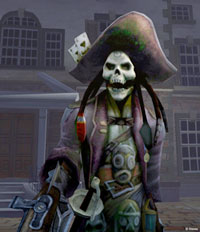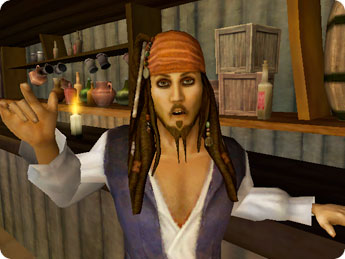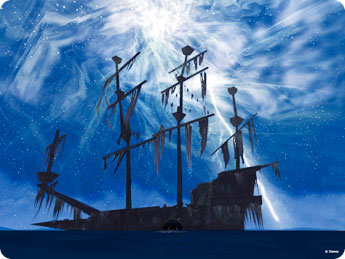Goin’ on th’ Account: The History of Pirates of the Caribbean

Walt Disney’s original concept for Pirates of the Caribbean involved a wax museum depicting famous scenes from buccaneer lore. However, the company’s development of animatronic technology, which caused a stir at the 1964 World’s Fair, inspired him and his Imagineering team to employ something similar for a pirate ride.
The Pirates of the Caribbean ride opened in 1967 and became one of Disneyland’s most memorable attractions. Visitors board boats that take them through an idyllic Louisiana bayou setting before passing under an archway adorned with a skull that warns, in part: “It be too late to alter course, mateys. And there be plundering pirates lurkin’ in ev’ry cove, waitin’ to board.”
After plummeting down a waterfall, the boats take visitors past a variety of scenes featuring animatronic pirates, including the sacking of a town, before returning to the bayou. The ride was later adapted for the Disney amusement parks in Florida, Paris, and Tokyo, and changes made in 2006 incorporated many of the characters from the movies, including Jack Sparrow, Captain Barbossa, and Davy Jones, all voiced by the original actors who played them.
Goslin notes that concept art created by Marc Davis — one of Disney’s Nine Old Men — for the original ride also helped inspire his team. “His work is really fun, caricatured, and occasionally grotesque,” Goslin remarks.
Same Story, Different Versions
In 1999, Pirates of the Caribbean: Battle for Buccaneer Gold debuted at DisneyQuest, an indoor amusement park at Walt Disney World in Florida. The attraction, developed by Goslin’s team, allows visitors to take control of pirate ships and sink other vessels, attack sea monsters, and gather loot. “It was a lot of fun and had such strong appeal that when we later got into building MMOGs (massively multiplayer online games), one of our first pitches was to build one based on Pirates,” Goslin recalls.
Meanwhile, Rossio and Elliott weren’t the first screenwriters to work on the original movie, but their version of the story introduced supernatural elements that differentiated it from previous pirate films, Elliott relates in a post on the duo’s Web site, Wordplay. “The story in the ride … is backwards: you start out seeing the pirates in their cursed state, and then see the events that led to it,” he explains. “So, in a way, the first movie is a sequel to the story in the ride: the pirates trying to remove the curse by returning the treasure they stole.”
He adds: “The archetypes [in the movies] are fundamentally Jungian: the Trickster, the Superman, the Hero, the Shadow, Anima/Animus, etc. One of the decisions we made was to avoid the Manichean dualism typical of most fantasy-adventures, in favor of an existentialist point-of-view.
“We’re equal opportunity when it comes to re-inventing mythology — what Gibbs says about the Pelagostas believing Jack is a god trapped in human form who they will release by killing him. It’s a variation of a Japanese bear-worshipping tribe … You know what Tia Dalma says: Same story, different versions, and all are true.”
But will there be a fourth film? Rossio tells us: “I’d love to see a fourth film, and so would the studio, I imagine, and I daresay, also the fans. But no one will proceed unless there is the perception that the film can be great, that it lives up to the first three. That’s a bit of a wild card, as you can’t legislate inspiration.”

What Are You Lookin’ At, Mate? Jack Sparrow, at your service. No, wait, it’s the other way around.

Cue the Dramatic Music. Jolly Roger’s ship makes a grand entrance.
- Port Royal: This Jamaican city is the center of Caribbean commerce and piracy, making it the perfect home base for your adventures. Elizabeth Swann and Will Turner live here.
- Tortuga: Jack Sparrow and Joshamee Gibbs frequent the Faithful Bride Tavern on this lawless island. You’ll also find plenty of poker and blackjack games happening at the bar, but be careful while wandering the wilderness: You may run across some very powerful creatures.
- Kingshead: Beware: Lord Beckett’s East India Trading Company (EITC) runs its Caribbean operations from this island. Stay away unless you have a very high level of notoriety and want to tangle with formidable Royal Navy officers and EITC mercenaries.
- Padres del Fuego: An enormous volcano makes this island easily recognizable from a distance. Don Victorio is Padres del Fuego’s governor, presiding over a populace who dislike pirates but hate Jolly Roger the most. A complicated network of caves hides not only treasure but also the EITC’s new silver mine, which may be more than it seems.
- Cuba: Tia Dalma lives in the swamps surrounding the Pantano River delta. She’s happy to teach you more about voodoo, but watch out for the creatures corrupted by Jolly Roger’s powers. Skeleton pirates reanimated by the cursed pirate captain also roam the landscape.
- Devil’s Anvil: This island near Tortuga is home to Barbossa and his pet monkey.
You’ll also come across many unsettled islands. Some are home to Jolly Roger’s corrupted creatures and reanimated skeleton pirates, while others seem deserted. Those islands may not stay uninhabited for long, however, as Goslin points out: “We will continue to add new content from the movies as well as original content in future updates to the game. We have a lot of great features queued up.”
- Captain Jack Sparrow: As in the movies, Jack operates according to his own agenda, which may or may not coincide with your needs. He’ll often ask for your help, though, so take on his missions to build plenty of notoriety.
- Elizabeth Swann: You can always count on her to help you with the finer details of the Pirate’s Code, such as when you should invoke parlay. In addition to helping you free the Black Pearl, she trains you to use a dagger.
- Will Turner: His love for Elizabeth ensures that he stays at Port Royal, where he teaches swordsmanship in his blacksmith shop.
- Tia Dalma: She dislikes both the Royal Navy and the EITC, and she’s happy to teach voodoo to anyone who wants to use it against both of those foes.
- Captain Hector Barbossa: He gives you a pistol and teaches you to use it. Barbossa also helps pirates settle disputes with combat, staying true to the Pirate Code in the process. He and Jack the Monkey live on Devil’s Anvil.
- Joshamee Gibbs: A former Royal Navy officer, Gibbs now operates as Jack’s right-hand man. He won’t trust you at first, but you can work your way into his confidence.
Jolly Roger: A poker game between Jolly Roger, Jack Sparrow, and a voodoo practitioner named Amo Dorsi went horribly wrong when Jolly Roger was unable to steal Jack’s most important possessions from him, as he had pre-arranged with Dorsi. Jolly Roger shot Dorsi, who placed a curse on the pirate before dying.
Now Jolly Roger wants revenge on Jack, and he plans to become Pirate Lord of the Caribbean in the process. He uses his powers to raise dead pirates from the grave, putting them to work in his army. He has also corrupted many of the creatures living on the Caribbean islands.
- Mac OS X version 10.4.6
- PowerPC G4 or Intel processor
- 512MB of RAM
- 700MB hard disk space
- Broadband Internet connection
